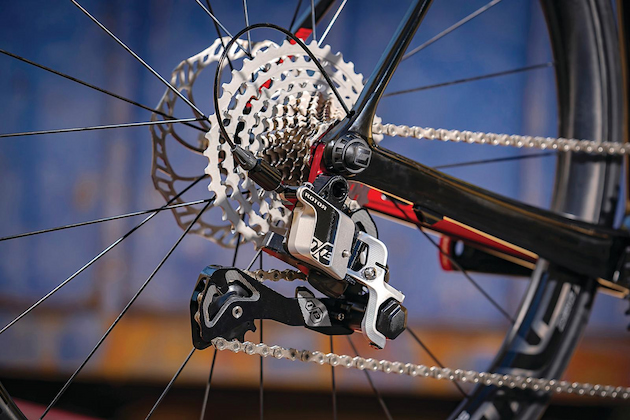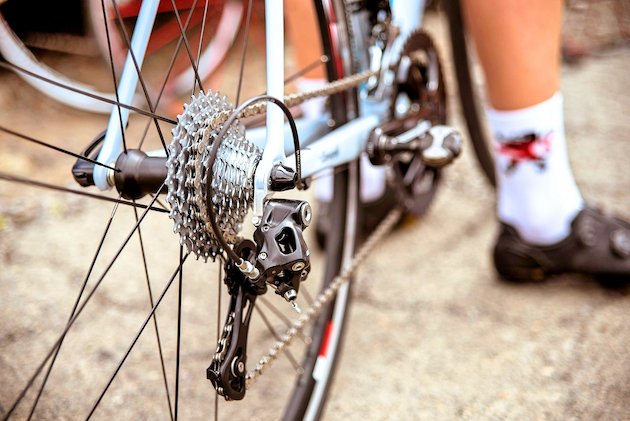Bikes are the sum of their parts. But change one part and this affects the bike as a whole. Take the case for bike cassettes. This is the set of sprockets found in all bikes (apart from single-speed fixies), that allows riders to change gears up or down, depending on how the terrain changes as you ride. Most newbies stick to the stock cassettes they got with the bike. This is to the point that they need more scope for different types of riding, and when tackling both steeper inclines or longer stretches of flat roads as fitness levels pick up. Of course, advanced wear is another obvious reason to start shopping.
What are Cassettes?
This is the group of individual cogs or sprockets located at the rear hub. The number of sprockets varies in different bikes and cassettes. This can be between 7 to 13 individual sprockets and is what determines your bike’s gearing, essentially the range of gears that allows for a steady pedalling pace (or cadence) as the road conditions change.

Each sprocket has a defined number of teeth that grip the chain, and this number increases in each subsequent sprocket. When shopping, cassettes are listed with the number of teeth in the smallest sprocket and that in the largest sprocket, as well as the overall number of sprockets or ‘speeds’. For instance, a common type of cassette in road bikes is the 11-34T 12-speed bike cassette meaning the number of teeth ranges from 11 to 34 from smallest to largest cog.
What is the Purpose of All Those Gears?
Older bikes came with 7 gears, or 8 if you are lucky. But today the larger spread of gears helps riders in a few ways:
• Smoother Shifting – The incremental increase in the number of teeth between one cog and the next means that the derailleur needs less work to move the chain. Shifting is crisper and quieter, but more importantly faster, even under load. Riders won’t need to exert extra effort in pedalling, so can maintain a steady pace. Adversely, adjacent cogs with big differences in size and the number of teeth will have harsher gear changes, and can soon wear riders out.
• Range – The more gears the bigger the range. Of course, this depends on sprocket ‘spacing’ (the difference in the number of teeth) and the size difference between the biggest and smallest sprocket. This is what makes it equally easy to tackle steep inclines or build up decent speed when the road eases out. More gears, then, are all about riding versatility. The same bike with a wide gearing range allowed by a bigger cassette can take you places other bikes and riders will struggle.
• Less Wear and Tear – Bike parts manufacturers, like Shimano, SRAM and Campagnolo that are by far the best known, have put in a lot of work in cassette design, particularly regarding teeth profiles. Not only does this aid smoother shifting, but causes less wear. Gears that have smaller jumps from one to another fare best in this respect, as there’s less friction from the chain.
Types of Bike Cassettes
Cassettes are generally divided into mountain and road bike cassettes. A recent hybrid between the two are cassettes used in gravel bikes.

Mountain Bike Cassettes
The mountain bikes need to have a larger gearing range to cater to the variety of gradients in which these bikes are typically used. The largest sprockets will not only be bigger than what you’d find in road bikes, but the spacing between them is also more pronounced. This essentially means that shifting between gears isn’t quite as smooth. The inclusion of more sprockets though, and the fact that most high-end mountain bikes now have a single front chainring helps to reduce the jump between gears as well as cut down on weight, while still retaining high range.
Today many mountain bikes have an 11 or 12-speed bike cassette and the newest variants add one more sprocket. Shimano has the Deore CS M6100 10-51T 12 speed as an inexpensive entry point here. Higher up you’ll find the XTR CS-M9101 10-51T that promises smoother and faster shifting, and at the fraction of the weight.
SRAM starts with the NX Eagle PG1230 10-50T and offers some exotic metals and improved designs when you shell out more cash for something like the 12-speed XX1 Eagle cassettes. Both brands have quite a few mid-level cassettes that, apart from the slightly higher weight, won’t lose out much in performance from the priciest models.
Road Bike Cassettes
These tend to have smaller sprockets, and shorter gearing ranges. The benefit though is smooth and swift shifting. Entry-level road bikes start with 8-speed cassettes, but now 11 and 12-speed cassette offerings seem to be the norm in bikes occupying the mid and high-price brackets. The good news for riders is that the once cutting-edge tech is now trickling down into more affordable cassettes.

A good example is Shimano’s new 105 groupset, with the 12-speed shifting derived from previous versions of the more expensive Dura-Ace and Ultegra lines. If you’re not hoarding your cash, then get the recent Ultegra 8100 or Dura-Ace 9200 series of cassettes. These are offered in different ranges, with 11-30T and 11-34T being the most common. For SRAM enthusiasts, go for the Red eTap AXS or Force eTap AXS 12-speed cassettes, which like comparable Shimano versions have wireless electronic shifting.
What to Look for in Bike Cassettes
Weight and materials are related and are what affects the price of cassettes most. Newer cassettes are getting lighter due to the choice of lighter metals (titanium and aluminium) compared to traditional steel. But does a cassette that’s five times the price of an entry-level variant, offer 5 times the performance? The short answer is a definite no. You’re paying for the weight savings and slightly smoother shifting experience. And longevity seems to be on par for both versions.
When changing out your old cassette for something new, ensure that other drivetrain parts (shifters, derailleurs, chains and cranksets) are compatible with what you’re getting. In addition, ensure that the cassette fits the freehub. Shimano has done a good job here in that their new 12-speeds are backwards compatible and fit an existing 11-speed road freehub.


